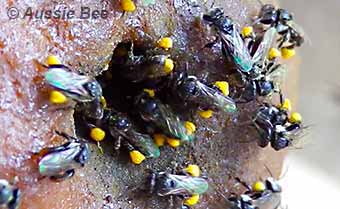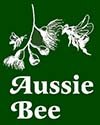SOUTH AFRICAN SMALL HIVE BEETLES
A Serious New Pest of Bee Hives in Australia
An Australian Native Bee Research Centre Report
14 December 2005 -- Updated July 2010
Aussie Bee > Keeping Stingless Bees > South African Small Hive Beetles
Small Hive Beetles (Aethina tumida) from South Africa are a major pest of commercial honey bees (Apis mellifera). In 2002 these beetles were discovered in commercial honey bee hives near both Sydney and Brisbane in Australia.
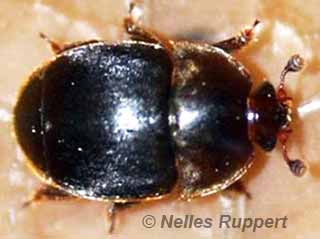
South African Small Hive Beetle. Photograph by Nelles Ruppert, Martin-Luther University, Halle, Germany.
Expected Impact on Australia’s Commercial Honey Bees
South African Small Hive Beetles can be very destructive in Apis mellifera hives. The beetles lay eggs inside the hive and the beetle grubs tunnel through the combs, causing the honey to discolour and ferment, and killing the bee brood. In bad cases the bees may abandon infested hives.
Originally from South Africa, these beetles spread to Florida, USA in 1998 and have now become widely established across the eastern half of the USA. In the first two years following their introduction to Florida these beetles caused the loss of 20,000 commercial honey bee hives. Australia’s climate and commercial honey bee varieties are similar to those of USA. So unfortunately the impact in Australia of these beetles may be similar to that seen in the USA.
Expected Impact on Australia’s Native Stingless Bees
The good news is that these South African beetles rarely seem to seriously damage Australian stingless native bee nests, as long as they are well sealed and intact. Many healthy stingless native bee hives from locations affected by the beetle near Sydney have been inspected. These included hives of varying strength from both Australian stingless bee genera, Tetragonula (previously called Trigona) and Austroplebeia. No signs of South African Small Hive Beetle damage were seen in these hives.
However, reports from Queensland show that these introduced beetles can be attracted in high numbers when a beekeeper is boxing or splitting a stingless bee hive. Great care should be taken to keep these beetles out of the hive until the bees have rebuilt all of their resin seals. Use a box design with no gaps in the joints and, after working on a hive, cover the box joints with tape.
Dr Peter Neumann and Dorothee Hoffmann from Martin-Luther University, Halle, Germany, visited the University of Western Sydney - Hawkesbury in 2005 and studied the impact of Small Hive Beetles on Tetragonula carbonaria stingless bee hives. They discovered that these beetles are far less attracted to Tetragonula hives than they are to commercial honeybee hives. Also all the South African Small Hive Beetles that managed to enter four well-established Tetragonula hives during the study were rapidly glued down to the nest structure with resin by the worker bees!
In 2006-2007 Megan Halcroft of the University of Western Sydney did a valuable study of the effect of these beetles on Austroplebeia australis hives. She discovered that these bees too can use nest resins as an effective defence against the Small Hive Beetles. Read Aussie Bee Online Article 12 for full details.
History of the Infestation
It is not known how the beetles found their way to Australia. However, it is likely that they had been here for over a year before they were detected in 2002. The adult beetles can fly up to 15 km and readily find honey bee hives, probably by smell. These beetles may also successfully breed in fruit such as avocado, rockmelon and grapefruit.
The Small Hive Beetle infestation was first reported in Richmond, NSW by apiary staff at the University of Western Sydney - Hawkesbury. Without the vigilance of the UWS apiary, this pest would have spread much further and caused more damage before it was detected.
Unfortunately hive movements from various Sydney apiaries, before the outbreak was formally recognised, had spread these pests to Stroud and Cowra in NSW and to Beerwah in Queensland.
It is impossible to eradicate these South African beetles from Australia at this stage because they have already spread to feral nests of commercial honey bees (Apis mellifera) in hollow trees. The Sydney region alone harbours thousands of feral Apis nests.
How to Recognise the South African Hive Beetles
Adult South African Small Hive Beetles are 5 to 7 mm (about 1/4 inch) long and vary from dark brown to almost black. Their white-coloured grubs grow to about 10 to 11 mm (about 7/16 inch) in length. When the grubs are mature they burrow into the soil underneath the hive to pupate.
The BeeAware website features good photographs of this South African pest: beeaware.org.au/archive-pest/small-hive-beetle/
An Australian Look-Alike Beetle
Native Australian beetles in the genus Brachypeplus, (see photograph below) are sometimes seen in hives of Australian stingless native bees. They scavenge for spilt pollen and normally cause little harm to the hive.
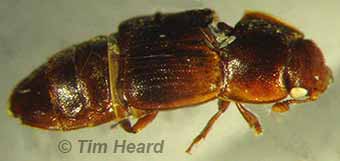
An oblique view of Brachypeplus macleayi, an Australian native species of hive beetle that is sometimes seen in Australian stingless bee hives. Photograph by Dr Tim Heard, Sugarbag Bees.
The Australian beetle adults are dark brown to black and look fairly similar to the South African beetles. However, the Australian beetles are only about 3 to 5 mm (3/16 inch) long. They are smaller, narrower and flatter than the South African beetles. The key differences between the Australian and the South African beetles are shown in the following diagrams.
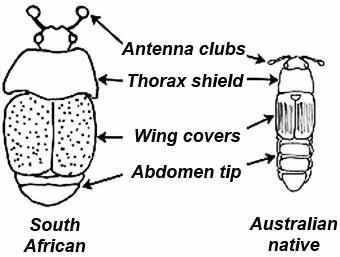
Above: Top view of a South African Small Hive Beetle (left) and an Australian native species of hive beetle sometimes seen in stingless bee hives (right).
Antenna clubs: The antennae of the South African beetle have slightly more prominent clubs
at their tips than those of the Australian beetle.
Thorax shield: The South African beetle has a much larger and broader shield over the thorax part of its body than the Australian beetle does.
Wing covers: The hardened wing covers (elytra) of the South African beetle are longer than those of the Australian beetle. The elytra of the South African beetle also are covered with a pattern of minute dots, while those of the Australian beetle have a series of fine parallel grooves.
Abdomen tip: Only about two of the final segments of the South African beetle’s abdomen are visible beneath its elytra, while more abdominal segments are visible on the Australian beetle.
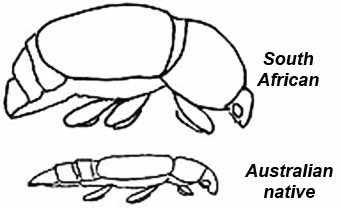
Above: Side view of a South African Small Hive Beetle (top) and an Australian native species of hive beetle sometimes seen in stingless bee hives (bottom). The Australian beetle is flatter than the South African beetle.
Article by Ric Wade about Small Hive Beetles and Stingless Bees
Video on Keeping Small Hive Beetles Out of Hives

